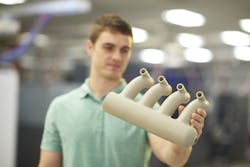3D Printing Gets Ready to Change Design and Manufacturing
3D printing is maturing rapidly with advances in materials and methods happening all the time. But is it ready to help manufacturing companies get an edge on the competition? To get a snapshot of where 3D printing technology is today, we talked with Kent Firestone, COO of Stratasys Direct Manufacturing, a leading provider of 3D printing and advanced manufacturing services. To learn more about 3D printing and to talk with experts from Stratasys, be sure to attend the Industrial Design & Engineering Show this May in Cleveland. (For more information and to see if you qualify for a free all-show pass, click here.)
What are the biggest engineering challenges for 3D printer companies? Bringing down the cost of 3D printers? Improving the capabilities of their offerings? Making 3D printers robust and durable enough, and perhaps fast enough, to handle more than low-production/prototype manufacturing? Are there any magic bullets or new technologies that could unlock many of these at once?
Firestone: We see many parallels between the biggest engineering challenges facing 3D-printing companies and those facing 3D-printing users. And because it’s our job to ensure their projects are successful, their challenges are our challenges. Our 2015 report, 3D Printing’s Imminent Impact of Manufacturing, surveyed 700 industry professionals and found the biggest hurdles were equipment and material and manufacturing costs, as well as limited materials. Speed of production and design accuracy were also on our customers’ radar.
Although we don’t see any magic bullets to address these challenges, solutions that remove or reduce barriers and push the industry forward are continually being developed. Lowering costs across the board (equipment, materials, etc.) will make 3D printing a more accessible and economical manufacturing option for companies. And while the technology has been used to create production parts for years, the continued development of machines means producing repeatable parts at an even faster pace will soon be a reality, enabling companies to use 3D printing for more high-volume production projects.
Does the industry need more standards on hardware and software to make implementation easier and more transparent for users? And if so, in what areas should the standards first take a whack at? And who should take the lead in setting standards?
Firestone: Users want to know what processes and practices will help them achieve high-quality parts, so establishing standards is a key issue in the industry today and a natural part of the technology’s evolution. Standards are important because they give engineers the ability to design to a set of parameters, creating a level of trust in the manufacturing process. But at this point, most major companies using 3D printing for production parts have had to create their own materials and processing guidelines. Another factor is design tools. Most of them don’t account for the advantages and disadvantages of 3D printing, so there’s a gap there that design standards should fill.
ASTM International, a standards development organization, is playing a prominent role in establishing standards. The organization collaborated with the Rapid Technologies and Additive Manufacturing (RTAM) to establish the Committee F42 on Additive Manufacturing Technologies in 2009.
The first set of standards revolved around terminology, which helped determine 3D printing as the umbrella term for the industry while additive manufacturing referred to production parts or more complex processes.
Creating standards for production parts is the next big step, because they require a level of standardization that hadn’t been part of the early rapid-prototyping movement. Before, success would be defined by vendors, which created an apples-and-oranges comparison between similar parts built with traditional technologies. Now, ASTM is helping develop standardized test methods and process improvements to help companies and users work under consistent 3D-printing guidelines. If there are standards on how part quality is reported, then we won’t be so focused on trying to regulate the actual manufacturing process. Machines will only be used if they yield a measurable quality result.
What tasks do you see 3D printing handling for manufacturers 10 years from now? What are the hurdles on the part of 3D-printer companies and on the part of manufacturers that stand in the way of this vision? Then what is your vision for 3D printing 20 years from now?
Firestone: Ten years from now, 3D printing will be an even more integral part of manufacturers’ production process. Thanks to technology and materials advancements, Stratasys Direct Manufacturing envisions more mid- and high-volume production as well as greater proliferation of production-parts manufacturing.
The hurdles to getting there are the same challenges we talked about earlier—equipment and material costs, production speeds, material options, standardization, etc. We’ve started to see a glimpse of what technologies and capabilities are down the road with the debut of Stratasys’ Robotic-Composite and Infinite Build 3D Demonstrators in addition to others like Carbon and the Figure 4. Manufacturers will also have to think about personnel and internal expertise, in-house vs. outsourced production, and supply chain disruption.
It’s hard to say where the industry will be 20 years from now, given how much has changed in the past few years alone. However, we see 3D printing taking on a more prominent production role in the manufacturing world, specifically when it comes to high-volume runs of production parts. It’s likely more large and midsize OEMs will follow the leads of GE, Boeing, and other pioneers in incorporating the technology into their production processes to not only unlock new design capabilities, but also to improve their bottom lines.
Do you see any quantum leaps in 3D printing coming down the pike? If so, can you give us an idea of what they are? Or will advances be more incremental in terms of speed, build size, quality of finished product, materials used?
Developments in design tools and education, along with a surge in industry visionaries, hold the potential to move the industry forward in big ways. Most CAD software is built around current manufacturing methods, which doesn’t allow 3D printing to maximize its design abilities. If new software is created, then education and training will have to follow. In terms of industry visionaries, if more and more major companies follow the lead of GE and Boeing by making sizable investments in the technology, then they will also propel the industry forward. Just like Samsung, Google, and Microsoft had to respond when Apple introduced the iPhone, manufacturing giants have to respond in kind or risk being left behind.
Some of the incremental growth is coming in the form of materials advancements, specifically with metals. New materials like Monel, K500 (a precipitation-hardenable nickel-copper alloy), and PEKK CF HT23 (a carbon fiber-filled, high-temperature plastic) are enabling new applications across multiple industries such as aerospace and automotive. The continual development of materials and the quantification of new material properties will further progress the industry.
On the whole, it’s hard to predict the future in this industry, but there are hints as to what’s next. There are advancements being made in materials, processes, and Big Area Additive Manufacturing; brand new technologies are being developed; and we’ve even seen additive and subtractive methods combined in a single platform. That said, process repeatability will remain a key area of improvement. That, in combination with real-time or “in situ” monitoring, will elevate the capabilities of these technologies and the parts they produce. Reproducibility at a scalable, industrial level follows from that.
Is 3D printing (and modeling for 3D printing) an important technology that should be taught in engineering colleges (undergrad)? And if so, what courses might be eliminated to make room for 3D printing?
Firestone: 3D-printing coursework certainly has a place in engineering colleges. It’s a rapidly growing and evolving technology that is a key part of manufacturing’s future. But we don’t see this as a zero-sum game. Just because 3D printing should be taught in college doesn’t mean other processes should be eliminated from curriculums. We view 3D printing as a complementary rather than displacing technology.
What’s the biggest misconception engineers and designers have about 3D printing? And what’s the biggest misconception manufacturing managers and company owners have about it?
Firestone: The biggest misconception we tend to see is one we debunk every day: that 3D printing can’t produce functional parts. Greater material options and more rigorous process controls have transformed 3D printing into a dependable production solution, helping turn skeptics into believers. Additionally, some companies have an “all or nothing” view of 3D printing. We’ve run into people who believe 3D printing can replace all manufacturing and don’t want to bother with conventional technology. Others have written it off as a prototyping process and design sandbox. Subscribing to either of those philosophies will not properly prepare companies to maximize 3D printing.
Is there anything else you feel engineers need to know about the technology?
Firestone: When considering 3D printing, engineers should look beyond prototyping and low-volume runs. Although its many advantages for those applications are well-known, there are many circumstances where 3D printing can be used that they may not have considered before. Jigs, fixtures, tools, and assembly components are all applications where using 3D printing can benefit engineers.
I’d like to stress again that engineers shouldn’t view 3D printing through an “all or nothing” lens. Using this technology anywhere and everywhere it makes sense—and even in tandem with traditional manufacturing—can result in some major benefits for them.
To learn more about how 3D printing is driving change across industries by improving product innovation, shortening times to market, and streamlining traditional manufacturing processes and reducing costs, be sure to attend the ID&E show this May in Cleveland. You can hear from the experts and talk with them. For more information on the show, and to see if you qualify for a free all-show pass, visit the ID&E website.


